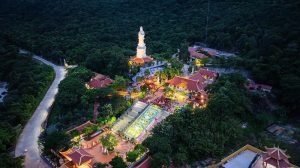Hanoi, being the dynamic capital of Vietnam, has a lot to offer in terms of history and culture. The most interesting historical and cultural spot is probably Quan Thanh Temple or Tran Vu Temple. With its pretty interesting history, architectural beauty, and spiritual significance, here is a deeper dive into the captivating world of Quan Thanh Temple Hanoi.
About Hanoi Quan Thanh Temple
The bustling capital of Vietnam, Hanoi is an attractive city, rich in historical inheritances and bearing a lively mark on its cultural forefront. Attracting a lot of attention within the city’s vicinity is the Quan Thanh Temple: huge, magnificent, and situated right at the north of the city. Quan Thanh is a very ancient temple and one of the most interesting sights that every visitor traveling to Hanoi should pay a visit to, especially during springtime after the Tet holiday.
Temple de Quan Thanh originally dates back to the Early Ly Dynasty in 1010. It was dedicated to Huyen Thien Tran Vu, a deity that represents one of the most interesting combinations of Vietnamese and Chinese mythology. In the unique character of Huyen Thien Tran Vu, a legendary Vietnamese king known as An Duong Vuong merges with a Chinese mythological character called Chan Vo Tinh Quan.
Its worship contained herein harmoniously integrates both Taoism and Buddhism. To date, Quan Thanh Temple has undergone seven renovations, the last one in 1941. In 1962, the temple officially gained recognition as a national historical and cultural relic.
Quan Thanh Temple Hanoi has come to represent the eternal symbol of the heritage, history, and culture of Hanoi. Its serene surroundings, architectural beauty, and spiritual profundity have made the site appealing both to locals and visitors. Be it a need for a tranquil atmosphere, a desire to pursue the historical evidence that marks the city, or an urge to be immersed in Vietnamese culture, Quan Thanh Temple surely presents an experience you will never forget.

Explore the Architecture of Hanoi Quan Thanh Temple
Quan Thanh Temple is one of the most critical reflections of the evolving cultural and religious landscape of Hanoi. While originally inspired by the basic principles of Buddhist design, its architecture has been significantly influenced by the Nguyen Dynasty’s architectural style through several renovations in recent centuries.
A Grand Entrance
Before the temple complex are four huge imposing pillars, which guard the four main pillars and are decorated with four huge great Vietnamese phoenixes. On the top of each pillar stands one Vietnamese unicorn, making the entrance very dramatic. Pairs of red couplets, and traditional Chinese poetic inscriptions, further embellish the gate of the temple.
The Heart of the Temple: Tran Vu Statue

Inside the main hall of Quan Thanh Temple is a striking black bronze statue of Huyen Thien Tran Vu. The magnificent statue, at 3.96 meters in height and weighing 4 tons, is a true wonder of craftsmanship in bronze casting. Intricate carvings and details in the statue are evidence of excellent craftsmanship by artisans in the 17th century.
Elaborate Wood Carvings
Apart from the bronze statue, Quan Thanh Temple is also famous for its excellent wood carvings. All the wooden parts of the temple are ornate with sacred animals according to Vietnamese mythology and symbolic plants like pine, bamboo, chrysanthemum, and apricot. These carvings depict earthly and celestial activities that add to the rich tapestry of the temple.
A Harmonious Fusion

The architectural style represented by Quan Thanh Temple is harmonious, with various styles and influences combined. The imposing colors of the flagrant pillars at the entrance of the temple welcome many people. In the middle of the main hall, there is a statue with carvings that make this place more artistically and culturally valuable. The reflection of deep-rooted history in its architectural design denotes its purpose as a house of worship and a part of cultural heritage.
The Best Guide for Your Visit to Quan Thanh Temple Hanoi
Lily’s Travel will provide you with the most important information to ensure your best experience while visiting Quan Thanh Temple Hanoi:
Location and Opening Hours
Quan Thanh Temple is located at 190 Quan Thanh Street, Ba Dinh District, Hanoi. Quan Thanh de Temple opens to visitors every day of the week from 8:00 AM to 5:00 PM. On the Lunar New Year’s Eve, the temple opens all day. On the 1st and 15th of a lunar month, the temple is open from 6:00 AM to 8:00 PM.
Entrance Fee and Dress Code
Admission to Quan Thanh Temple Hanoi, the place charges a small fee of 10,000 VND per adult ticket and 5,000 VND for students and children tickets. It would be proper to show respect for the sacred space by dressing modestly: shoulders and legs must be covered.
A Center of Religious and Cultural Activities
Besides its historical and architectural value, Quan Thanh Temple is an active religious and cultural center in Hanoi. Visitors can either witness or join the various religious rites and festivals in order to be enlightened with the spiritual tradition of the temple.
Best Time to Visit
Quan Thanh Temple Hanoi remains open to visitors every single day of the year. However, the first day of a lunar month is much more significant since locals flock to the temple and burn incense sticks to seek blessings. During this time, it also sees high school students visit to understand the history of Hanoi.
Another sacred time falls on Lunar New Year’s Eve, at which Quan Thanh Temple is bustling with locals to worship and pray for good luck. Although it is a bit cold in this weather, the temple’s significance draws people from all walks of life.
How to Get to Quan Thanh Temple

The shortest route to Quan Thanh Temple is via Lang – Lang Ha – Hoang Cau – Ton Duc Thang streets. From Ton Duc Thang Street, just go a little on foot to the temple.
By bus, several routes are passing Quan Thanh Street. You can take the following buses from: numbers 50, 45, and 22A. It will take a 5-10 minute walk up to the temple from the bus stop on Quan Thanh Street.
Read more: The Delicate Art of Bun Thang Hanoi
Other Famous Temples in Hanoi to Add to Your Travel List
Hanoi shelters some historic temples that promise to provide unforgettable experiences to its viewers. A few are suggested here that must be included in your tour schedule:
- Tran Quoc Pagoda: A pagoda, located on an island in the West Lake of Hanoi, is the oldest pagoda; the view of this is outstandingly fascinating and enshrouds you in soothing tranquility.
- Ngoc Son Temple: It is situated on Jade Island in Hoan Kiem Lake and is a temple dedicated to the national hero – Tran Hung Dao. It is the most frequent place for locals and visitors.
- One Pillar Pagoda: The peculiar pagoda has been constructed on one pillar of stone and reflects the ingenuity of the architecture of Vietnam.
- Temple of Literature: This is one of the temples devoted to Confucius and his disciples; it is also known as the National University of Vietnam. Being a historical landmark, it remains to this day one of the most sought-after educational places in the country.
- Perfume Pagoda: Located in the beautiful mountain range outside Hanoi, the complex of temples and pagodas spreads out. It is indeed a very great pilgrimage site; however, the spring festival tends to be the most frequently visited season.

- Bach Ma Temple: A small temple with historic value, built in the 11th century. It is believed to have played a role in the founding of Hanoi.
Among many temples and pagodas available in Hanoi that you can visit, each has something different to offer with glimpses into the rich history and culture that exist in this city.
Quan Thanh Temple is the typical representative of the rich history and diversified culture in Hanoi. Its architecture is so attractive, spiritual meaning so important, and its atmosphere so tranquil that it would be a regret to skip such a sightseeing location when going on a tour around this ancient city. Check out this guideline from Lily’s Travel to arrange a visit that is full of memory and emotion to this historical relic.
Readmore: The Legend of Bach Ma Temple: Hanoi’s Guardian Spirit















